Shock Trouper—Joan Collins
The first time I ever saw Joan Collins, she was on the way ‘to the airport with Arthur Loew, Jr., and the last time I saw her she was on the way to the airport with Arthur Loew, Jr.
That’s a lot of airport and a lot of Arthur Loew, Jr.
But that’s Joan’s life lately—saying goodbye to Arthur Loew, Jr. and flying somewhere such as Jamaica, England or Hollywood to make a picture. However, much as I like Mr. Loew and his nice sense of humor, I was glad to have him out of my sight for a spell while I studied this green-eyed, dark-haired, 23-year-old English-accented glamour gal close up.
“I’m down in the lobby,” I said, on the hotel phone, on one of the days when we had appointments.
“Do you want me to come down?” Joan asked.
“Why don’t I come up?” I replied.
“Oh?” She sounded a little scared.
“I mean, if we’re going to take some pictures of you.”
“All right!”
When I got there, the door of her room was open. I rapped gently, anyway, and Joan sang out gaily: “Come on in!”
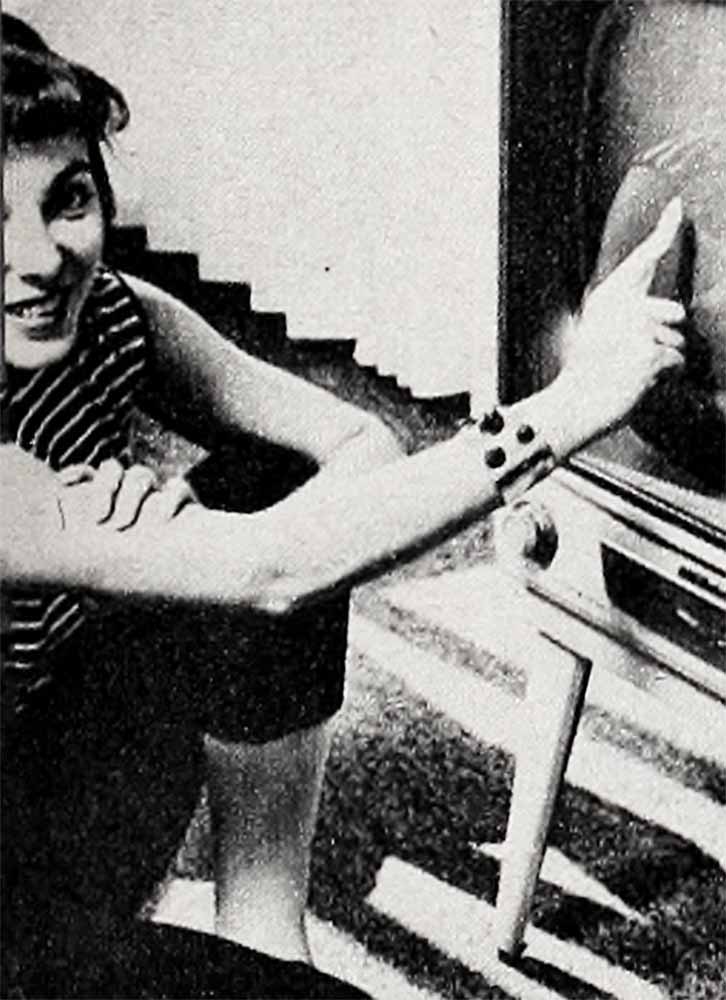
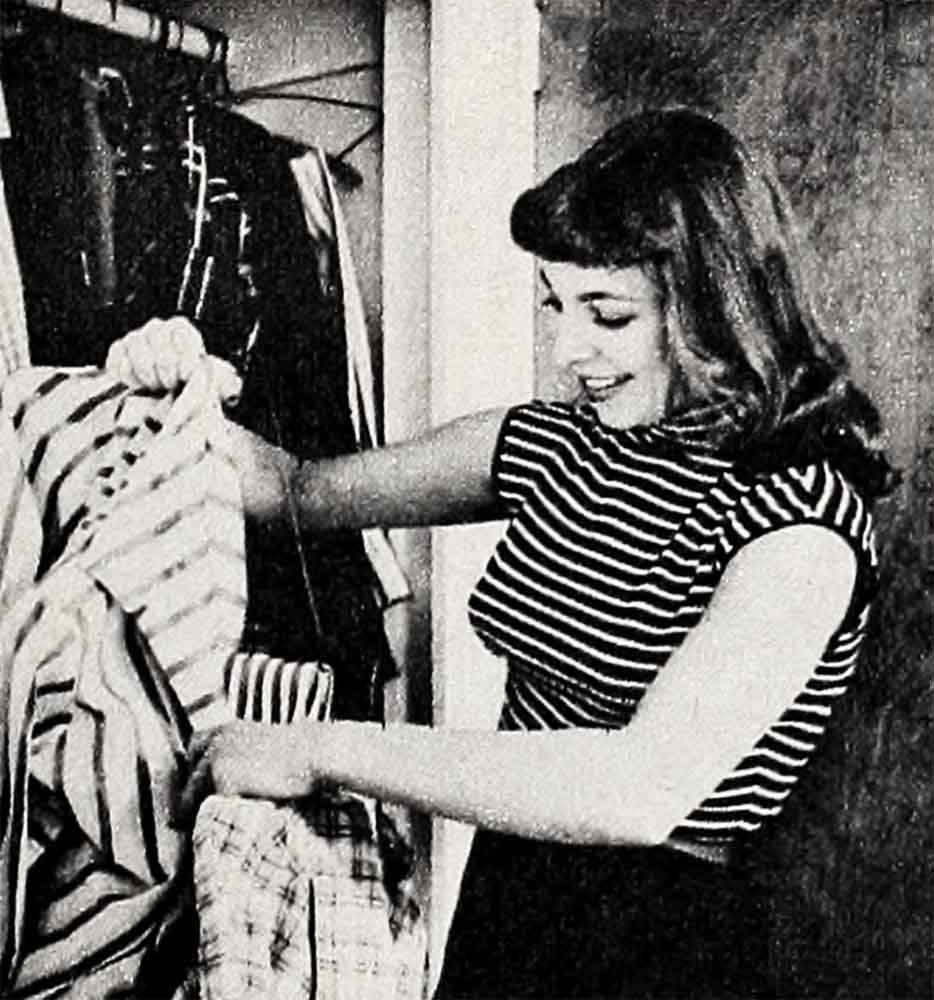
Such confusion, such ringing of the telephones! It was obvious that success had suddenly caught up with and overtaken Joan Collins. She might have expected show business would be good to her, since her grandmother had been a chorus girl, her aunt a London variety star, and her father, Will Collins, is now a prominent London theatrical agent.
Joan had made the grade by daring to leave merry old England and coming to the United States, where she hoped people would appreciate her more. Not that they disliked her there, but she didn’t impress them as much of an actress.
“Didn’t impress them!” As Joan tells it, “In England, I guess I had the worst reputation for acting of any person on the screen. The critics massacred me. They said I generally displayed my two bad expressions and gave my usual bad performance.
“Any time a script called for a bad girl or a girl who’d been done wrong by, I got the part. It was so boring. Besides, I thought I was miscast.”
Well, maybe they did dislike her—at least her acting.
So Joan took John Bull by the horns. Refusing to continue being laugh fodder for the critics, she got the J. Arthur Rank studios to peddle her contract to 20th Century-Fox. Then she hied herself to Hollywood. It’s a nice self, too. She’s a 38-23-36, pert and bouncy—and very honest.
“I hadn’t done a picture in England in nine months,” she says, “so I decided life was too short.
“Besides, I thought I’d love the relaxed kind of life in America, especially Hollywood. I guess it’s because I’m kind of easygoing.”
But now, two years later, she is far from relaxed, for success has set in. However, at twenty-three she has managed to get herself involved pretty well in all sorts of problems that she’ll probably look back on with amusement.
She has fallen in love—hard—and accepted a white mink stole from Arthur Loew, Jr. (whose father is one of the heads of M-G-M) as a birthday present. She wore it to see “My Fair Lady” with—yep, Arthur Loew, Jr.
But, in the midst of falling in love with Arthur Loew, Jr., she was also in the process of divorcing the husband she married when she was very young and inexperienced.
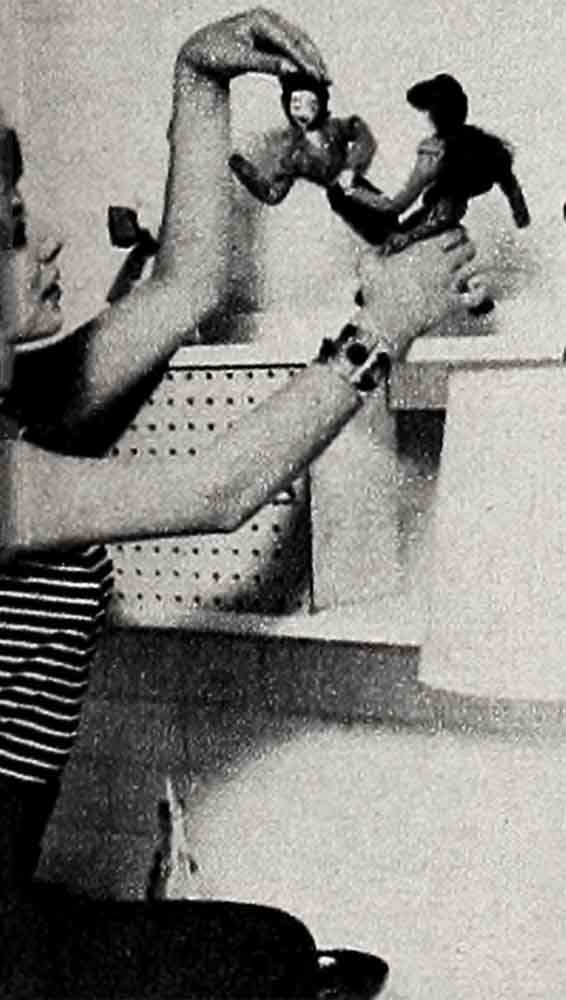
His name is Maxwell Reed and he was quite a British movie star when Joan was still in school. He was tall, handsome, British and all that. Joan had a crush on him—from afar—and had his picture on her desk even before they’d ever met.
When she was nineteen and still studying at London’s Royal Academy of Dramatic Arts, Joan married him.
“Don’t do it,” they told her—all her friends, relatives, parents, self-appointed advisers.
“The age difference, you know,” they mentioned. “Besides, you don’t know anything about life yet.”
Cocky, stubborn and impulsive, Joan told everybody, “I’m in love with him, and I’ll learn about life from him.”
And now Joan was lamenting to me that she had made a bitter mistake and that she only wished she had been willing to accept the advice of some of her elders, because a good marriage was important and she felt a decent attitude toward its conventions has to be maintained.
It was quite apparent now, that the guy in her life was Arthur Loew, Jr.—although for a time after coming to America she dated Sydney Chaplin.
Her husband, however, had come along to the United States and had sued her for $125 a month separate maintenance—equivalent to asking her to pay him alimony.
That made Joan thoroughly indignant. She felt like a wronged wife. Here she was, struggling to make good in pictures, torn emotionally because her marriage was ended, and at the same time defending a suit for separate maintenance. She was caught up in a sequence of events that would have been trying for a person much older and more experienced. Besides, of course, it was costly.
Then there was the additional though of her next marriage, to Arthur Loew, Jr.
Joan’s divorce wouldn’t be final for another year. By then—well, young Mr. Loew is quite a catch for almost any beautiful gal. And he’s been pursued by several in his time.
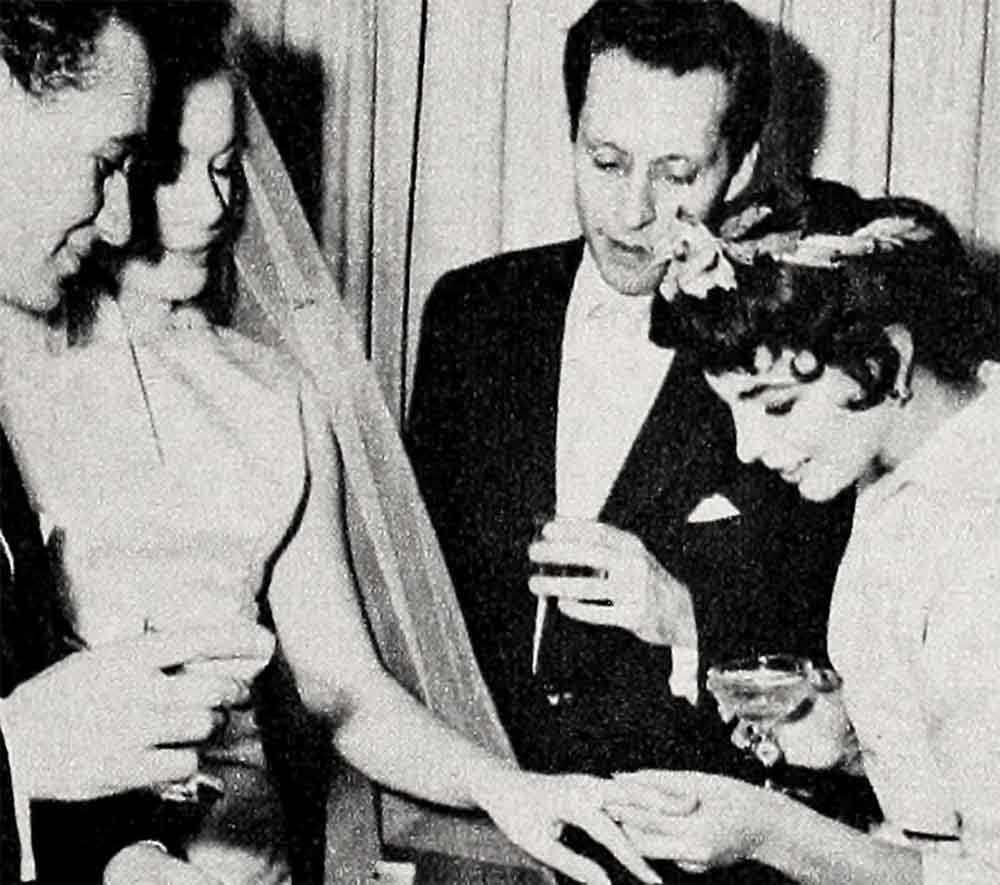
Joan tried to look at it sensibly. “For a girl who’s made a mistake like I did with one marriage,” she admitted to me, “the year’s waiting time is a good thing. It gives us time to curb our impulsiveness!”
At various intervals during our conversation, Joan had dashed into another room and changed into a bathing suit for some pictures . . . talked on the phone to some fans waiting downstairs . . . and discussed her latest film.
The name of the picture is “Seawife,” and Joan portrays a young nun who is on a shipwrecked raft with two men who try to make love to her.
“I’m on the raft with these men, trying to keep order,” Joan explained. “I’m also trying to fight off this strong feeling I have for Richard Burton. He is called Biscuit in the picture. Don’t ask me why. I’ve only read a synopsis so far. There evidently isn’t any script yet.”
“What do you wear on this raft?” I inquired.
“I think just a kind of calico slip. You see, as I understand it, we get shipwrecked in the middle of the night when I’m getting ready to go to bed.”
“How do you make out with the romance that is boiling up within you?”
“Well, I want to fall in love, but my religious feelings are stronger, and I take the final vows at the end.”
So we can all breathe easier about that!
In a sense, this role is a big triumph for Joan: she’d been called back to England to do it—and she’s not playing the usual bad girl. Maybe the English press will be impressed. It had already softened its attitude about her after she’d done “The Girl in the Red Velvet Swing.” And then another picture was coming out, “The Opposite Sex,” in which she took a bath—the same bath Joan Crawford took in the original movie version called “The Women.”
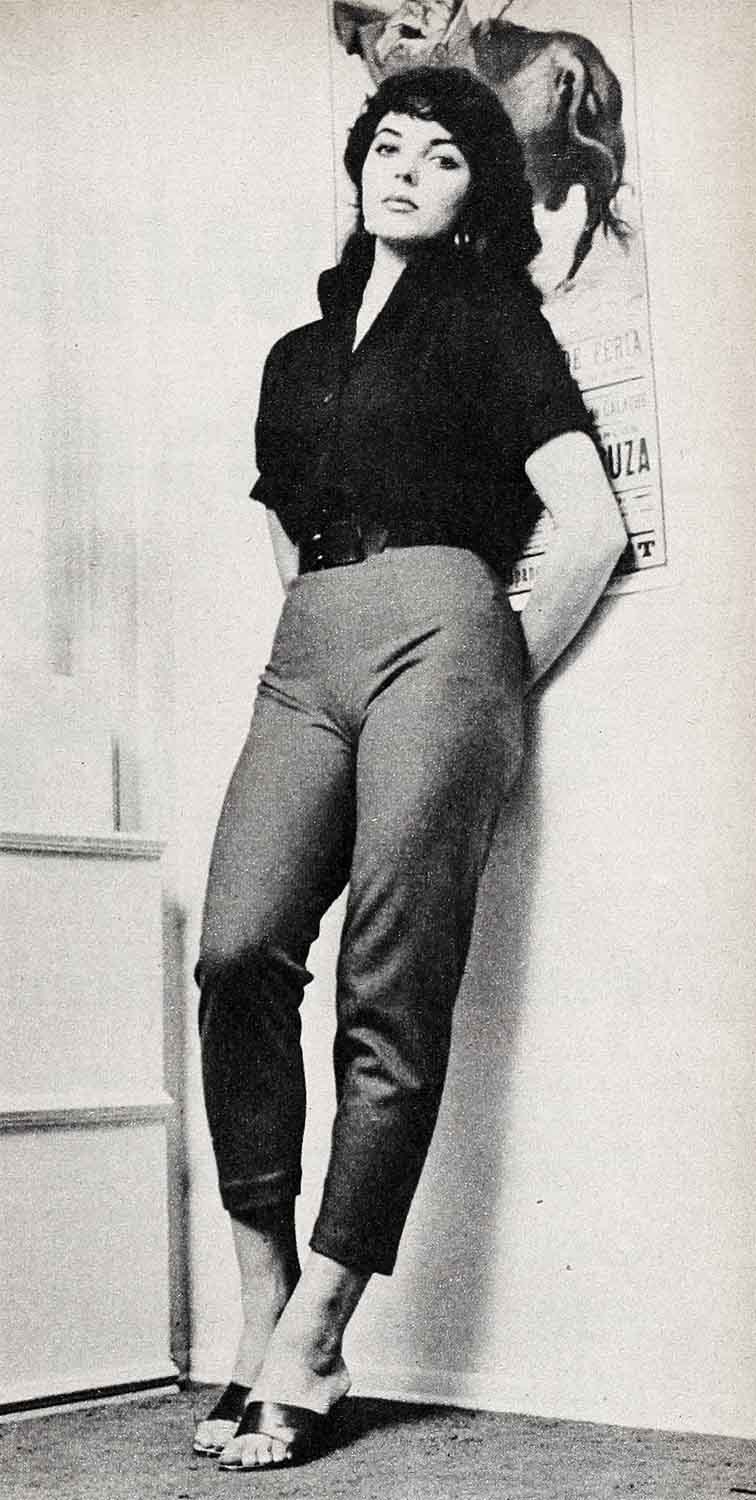
Bathtub fashions haven’t changed in all the years since. Miss Collins, like her predecessors, wears bubbles.
“What did you think of Diana Dors getting all that publicity at Cannes?” I asked her.
“I think anybody can get their picture in any paper they want if they do all kinds of sexy stuff.”
What about “Will Success Spoil Rock Hunter?”—the Broadway show in which Jayne Mansfield got so much publicity?
“I can’t stand dirt on the stage!” she retorted. “They were too obviously making cracks all the time about Jayne Mansfield’s bosom. That’s not theatre!”
Pointing out that she had. been on the stage since she was a child, Joan told me: “I go to the theatre every night when I’m in New York, and my ambition is to have my picture hang in Sardi’s.” (That’s the theatrical hangout where all the great stars’ caricatures line the walls.)
What did she want to do?
She told me that she’d like to do “The Story of Esther Costello,” which is about a deaf-blind girl of fourteen who is taken around the world and exploited, ostensibly to get money for the deaf. It is a very serious acting role, and it appealed to Joan.
“What would you like to do with your life?”
“I’d love to keep on acting as long as I can,” she said. “Eventually, I’d like to get married. I don’t want to live anywhere permanently. Maybe a year here, a few months in England, a year in Marrakech.”
“Do you literally mean Marrakech?” I asked, thinking of the city in French Morocco which is famous for gambling part of the year and so hot that the casino’s closed the rest of the year.
“Literally, no,” Joan conceded. “I just don’t want to live anywhere.”
“What do you think about all the low neckline pictures in America?”
“I think there is too much emphasis placed on one’s—you know . . .”
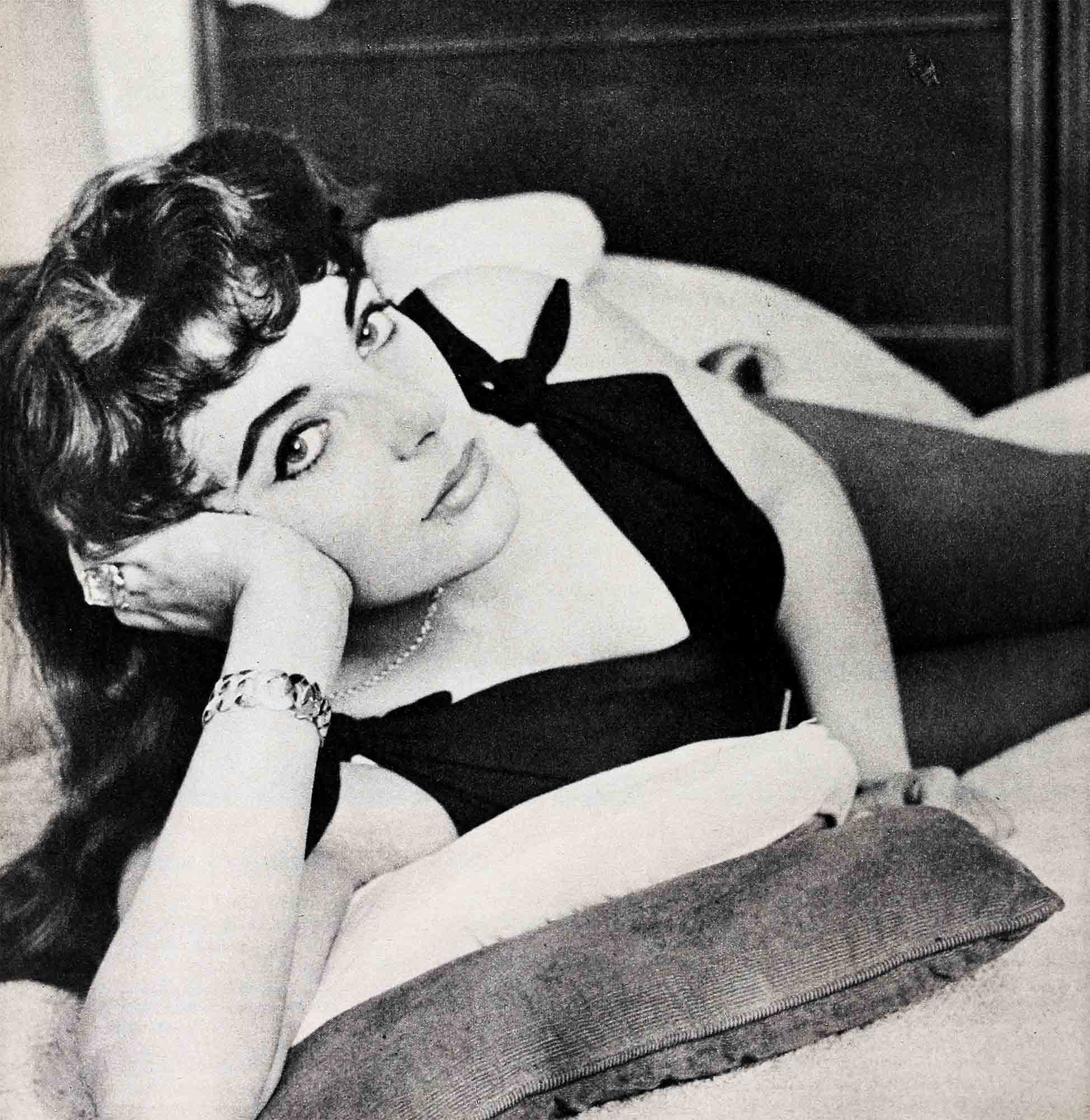
“Busts?”
“Yes!”
“But you said you weren’t against those pictures.”
“I’m not. But I hate the kind of cheesecake pictures girls do—such as at Thanks-giving cutting a turkey, or at Christmas dressed up in a Santa Claus Bikini. I don’t mind ordinary bathing suit pictures, although I’m getting kind of old for them, actually.”
“At twenty-three?” I said.
“I’m glad you don’t think so!”
Concerning marriage, Joan said quietly, “I’ve made one mistake and I would not want to get married again unless I decided it was forever and ever and ever. I’d hate to be one of those girls with four or five husbands!”
I mentioned to her that since her arrival in this country, she hadn’t had a lot of suitors. Sydney Chaplin and Arthur Loew, ones she’d dated, as far as I could see.
Why only two?
I, for one, hope that by now Joan is very, very popular in England, although stantly. As she pointed out to me, when she went back on one trip, the press people called. One said it was too bad how she’d gone Hollywood; she wore so much make-up you couldn’t get through the Cosmetic Curtain. Another said it was a pity that she came to meet the English press without any make-up on!
What’s a girl to do, sighed Joan. But she didn’t look very worried. This girl is the stuff of which shock troops are made!
THE END
It is a quote. PHOTOPLAY MAGAZINE SEPTEMBER 1956




